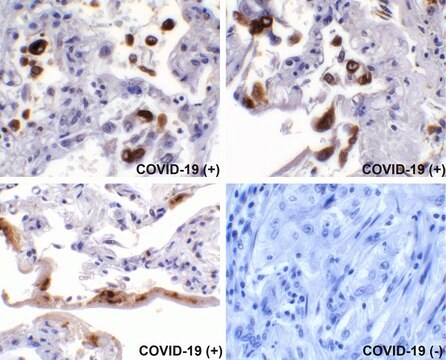MABF2815
Anti-SARS-CoV-2 Spike RBD Antibody, clone 6C2-G9
About This Item
Recommended Products
biological source
mouse
Quality Level
conjugate
unconjugated
antibody form
purified antibody
antibody product type
primary antibodies
clone
6C2-G9, monoclonal
mol wt
calculated mol wt 141.18 kDa
observed mol wt ~200 kDa
species reactivity
virus
packaging
antibody small pack of 100 μg
technique(s)
ELISA: suitable
immunoprecipitation (IP): suitable
neutralization: suitable
western blot: suitable
isotype
IgG1
UniProt accession no.
shipped in
dry ice
storage temp.
-10 to -25°C
target post-translational modification
unmodified
General description
Specificity
Immunogen
Application
Evaluated by Western Blotting in lysate from HEK293T cells expressing full-length spike protein of SARS-CoV-2 virus.
Western Blotting Analysis (WB): A 1:1,000 dilution of this antibody detected Spike glycoprotein in HEK293T cells expressing full-length spike protein of SARS-CoV-2, but not in lysate from wild-type HEK293T cells.
Tested Applications
Neutralizing: A representative lot neutralized SARS-CoV-2 Spike protein RBD to ACE2 in Neutralizing applications (Courtesy of Kento Abe and Anne-Claude Gingras, Toronto).
ELISA Analysis: A 1:3 dilution from a representative lot detected SARS-CoV-2 Spike protein. (Courtesy of Stefan Schüchner, Ingrid Mudrak, Ingrid Frohner, and Egon Ogris (Max Perutz Labs, Medical University of Vienna, Austria).
Western Blotting Analysis: A 1:400 dilution from a representative lot detected Sars-CoV-2 Spike protein in Whole cell lysates of HEK293T cells expressing full-length spike protein of SARS-CoV-2. (Courtesy of Stefan Schüchner, Ingrid Mudrak, Ingrid Frohner, and Egon Ogris (Max Perutz Labs, Medical University of Vienna, Austria).
Neutralizing: A representative lot neutralized SARS-CoV-2 Spike protein RBD binding to ACE2 receptor. (Abe, K.T., et al. (2020). JCI Insight 5(19):e142362).
Immunoprecipitation Analysis: A representative lot immunoprecipitated SARS-CoV-2 Spike protein. (Courtesy of Stefan Schüchner, Ingrid Mudrak, Ingrid Frohner, and Egon Ogris (Max Perutz Labs, Medical University of Vienna, Austria).
Note: Actual optimal working dilutions must be determined by end user as specimens, and experimental conditions may vary with the end user
Physical form
Storage and Stability
Other Notes
Disclaimer
Not finding the right product?
Try our Product Selector Tool.
Storage Class Code
12 - Non Combustible Liquids
WGK
WGK 2
Flash Point(F)
Not applicable
Flash Point(C)
Not applicable
Regulatory Listings
Regulatory Listings are mainly provided for chemical products. Only limited information can be provided here for non-chemical products. No entry means none of the components are listed. It is the user’s obligation to ensure the safe and legal use of the product.
JAN Code
MABF2815-25UG:
MABF2815-100UG:
Certificates of Analysis (COA)
Search for Certificates of Analysis (COA) by entering the products Lot/Batch Number. Lot and Batch Numbers can be found on a product’s label following the words ‘Lot’ or ‘Batch’.
Already Own This Product?
Find documentation for the products that you have recently purchased in the Document Library.
Our team of scientists has experience in all areas of research including Life Science, Material Science, Chemical Synthesis, Chromatography, Analytical and many others.
Contact Technical Service





